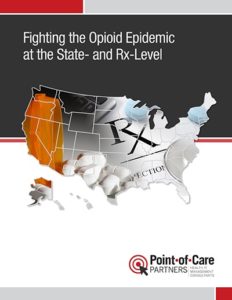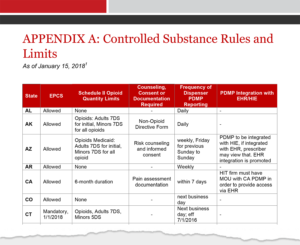By Tony Schueth
A first-of-its kind report that details how states are fighting the opioid crisis at the prescription level has been developed by Point of Care Partners (POCP). Unlike other reports in the marketplace, POCP’s new analysis is based on the most up-to-date information (as of January 2018) and focuses strictly on the range of state legislative and regulatory responses to opioid prescribing. Sadly, legal prescriptions are a root cause of the nation’s opioid epidemic because they often lead to fraud, abuse, diversion and addiction.
 Click image to preview report
Click image to preview report
POCP’s new 33-page report, Fighting the Opioid Epidemic at the State- and Rx-Level, was designed to help stakeholders understand the varying details and complexities of how states are addressing opioid prescriptions as a cause of the epidemic. It includes specifics organized around three main trends: prescribing; curbing fraud and abuse; and preventing and treating addiction. While a snapshot in time, this report provides insight into what some states are doing to address the crisis in their geography, and what others might add to their efforts.
The analyses are supplemented with 12 figures, including state maps indicating required use of electronic prescribing for controlled substances (EPCS) and consultation of Prescription Drug Monitoring Programs (PDMPs) by prescribers and dispensers.
Two Appendices summarize individual state responses on such key measures as consultation of Prescription Drug Monitoring Programs (PDMPs), integration of PDMP data into electronic health records and health information exchanges, frequency of opioid prescriptions and quantity limits and required counseling and/or consent for opioid prescriptions and related documentation. An example is shown here.
 Partial View of Appendix A
Partial View of Appendix A
Findings
The new POCP report has new and detailed data on state responses to opioid prescribing. High-level findings include:
- In total, as described throughout the report, eleven different mandates are being used across the states to combat the opioid crisis.
- The states with the highest-observed drug overdose death rates have implemented and proposed the most measures. Those states and their efforts are highlighted.
- A majority of states have enacted—or are considering—legislation requiring prescribers to consult PDMPs before prescribing. The report contains a table indicating state actions on a state-by-state basis.
- Several states have mandates in place that require prescribers to submit controlled substances prescriptions via EPCS, while others have proposed EPCS mandates in the last few weeks. The components of these mandates are highlighted in the report.
- An increasing number of states are limiting fill quantities and who can prescribe opioids and Schedule II narcotics, in addition to requiring additional data, such as diagnosis, on the prescription. The report provides details on a state-by-state basis.
- In another key trend, states are mandating that providers counsel and provide more education to patients around opioid prescribing.
If you want to learn more about the details, click here to purchase a copy of the report. A member of POCP’s Regulatory Resource Center team can also do a deep dive on this and other state prescribing-related issues. For more information, contact Connie Sinclair at connie.sinclair@pocp.com.




